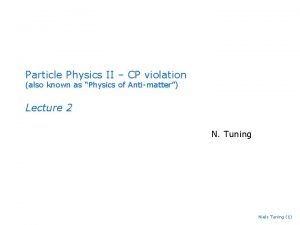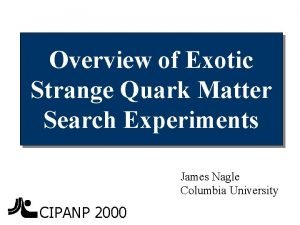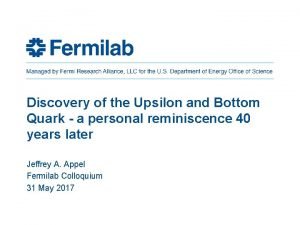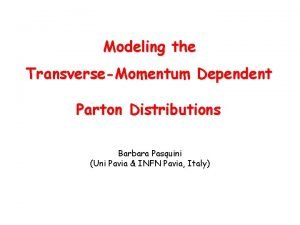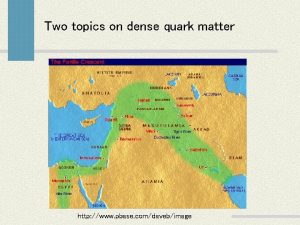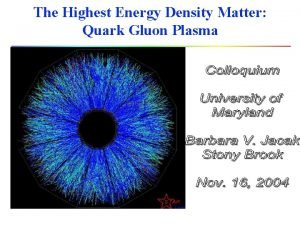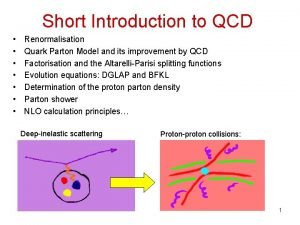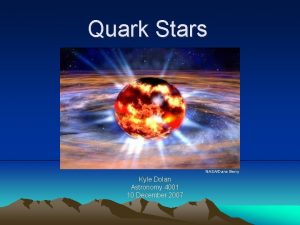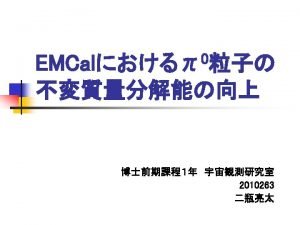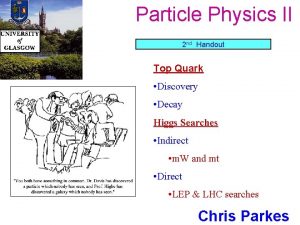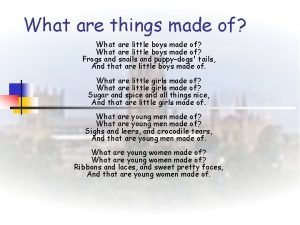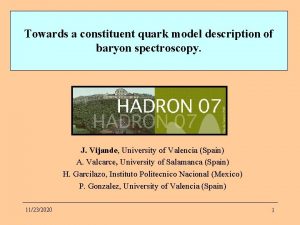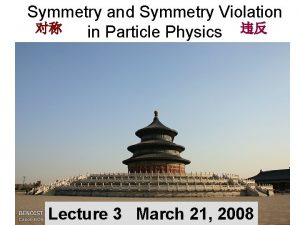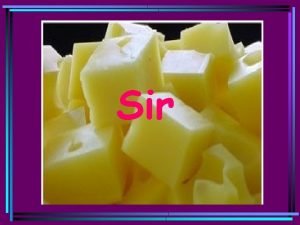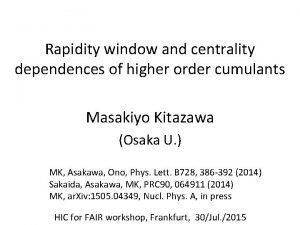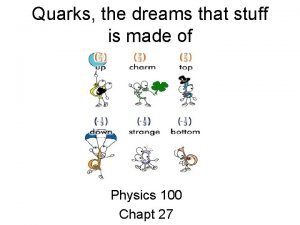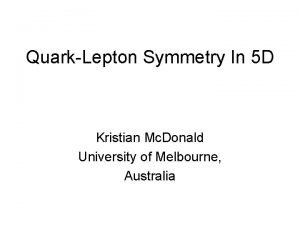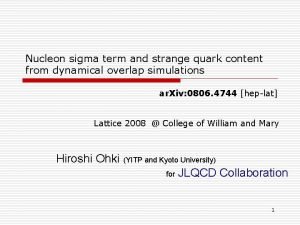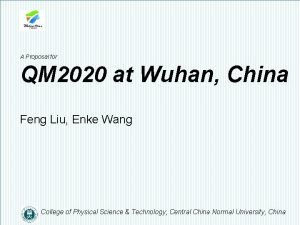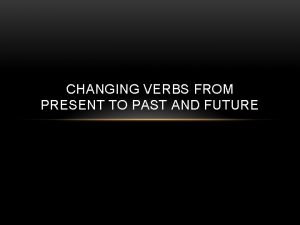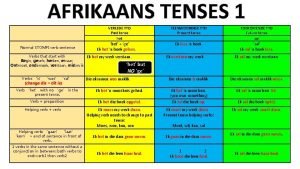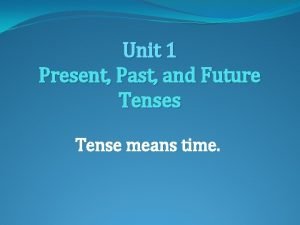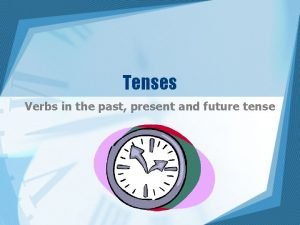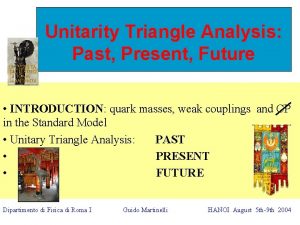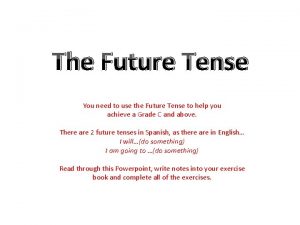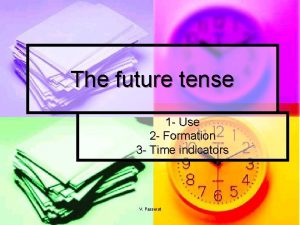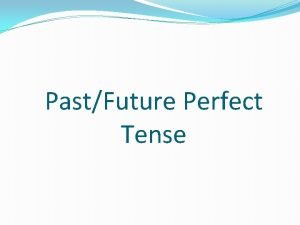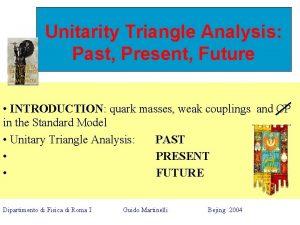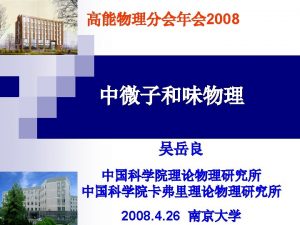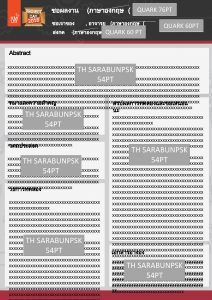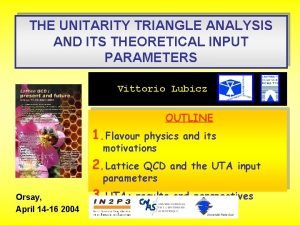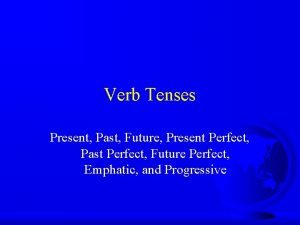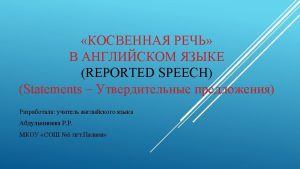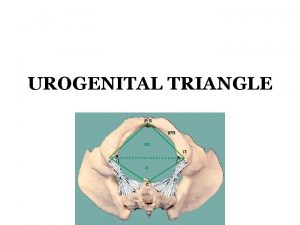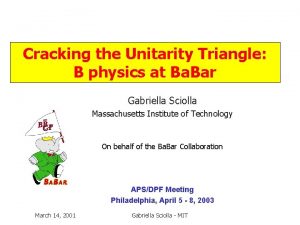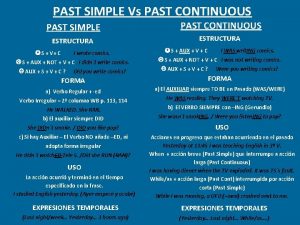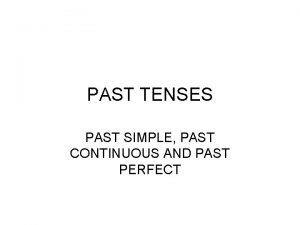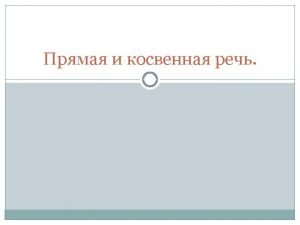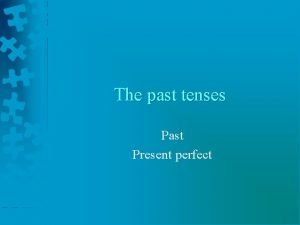Unitarity Triangle Analysis Past Present Future INTRODUCTION quark

























































- Slides: 57

Unitarity Triangle Analysis: Past, Present, Future • INTRODUCTION: quark masses, weak couplings and CP in the Standard Model • Unitary Triangle Analysis: PAST • PRESENT • FUTURE Dipartimento di Fisica di Roma I Guido Martinelli HANOI August 5 th-9 th 2004

C, CP and CPT and their violation are related to the foundations of modern physics (Relativistic quantum mechanics, Locality, Matter-Antimatter properties, Cosmology etc. ) Although in the Standard Model (SM) all ingredients are present, new sources of CP beyond the SM are necessary to explain quantitatively the BAU Almost all New Physics Theories generate new sources of CP

Quark Masses, Weak Couplings and CP Violation in the Standard Model

In the Standard Model the quark mass matrix, from which the CKM Matrix and CP originate, is determined by the Yukawa Lagrangian which couples fermions and Higgs Lquarks = Lkinetic + Lweak int + Lyukawa CP invariant CP and symmetry breaking are closely related !

QUARK MASSES ARE GENERATED BY DYNAMICAL SYMMETRY BREAKING Charge +2/3 Lyukawa ∑i, k=1, N [ Yi, k (qi. L HC ) Uk. R + Xi, k (qi. L H ) Dk. R + h. c. ] Charge -1/3 ∑i, k=1, N [ mui, k (ui. L uk. R ) + mdi, k (di. L dk. R) + h. c. ]

Diagonalization of the Mass Matrix Up to singular cases, the mass matrix can always be diagonalized by 2 unitary transformations ui. L Uik. L ui. R Uik. R uk. R M´= U†L M UR (M´)† = U†R (M)† UL Lmass mup (u. L u. R + u. R u. L ) + mch(c. L c. R + c. R c. L ) + mtop(t. L t. R + t. R t. L )

N(N-1)/2 angles and (N-1)(N-2) /2 phases N=3 3 angles + 1 phase KM the phase generates complex couplings i. e. CP violation; 6 masses +3 angles +1 phase = 10 parameters

NO Flavour Changing Neutral Currents (FCNC) at Tree Level (FCNC processes are good candidates for observing NEW PHYSICS) CP Violation is natural with three quark generations (Kobayashi-Maskawa) With three generations all CP phenomena are related to the same unique parameter ( )

Quark masses & Generation Mixing -decays down Neutron | Vud | e- W up Proton e | Vud | = 0. 9735(8) | Vus | = 0. 2196(23) | Vcd | = 0. 224(16) | Vcs | = 0. 970(9)(70) | Vcb | = 0. 0406(8) | Vub | = 0. 00363(32) | Vtb | = 0. 99(29) (0. 999)

The Wolfenstein Parametrization + ~ 0. 2 A ~ 0. 8 ~ 0. 2 ~ 0. 3 4 O( ) Sin 12 = Sin 23 = A 2 Sin 13 = A 3( -i )

The Bjorken-Jarlskog Unitarity Triangle d 1 e 1 a 1 b 1 a 2 b 2 a 3 | Vij | is invariant under phase rotations a 1 = V 11 V 12* = Vud Vus* a 2 = V 21 V 22* a 3 = V 31 V 32* a 1 + a 2 + a 3 = 0 (b 1 + b 2 + b 3 = 0 etc. ) b 3 c 3 Only the orientation depends on the phase convention a 3 a 1 a 2

From A. Stocchi ICHEP 2002


sin 2 is measured directly from B decays at Babar & Belle AJ/ Ks = J/ Ks (Bd 0 J/ Ks , t) - (Bd 0 J/ Ks , t) + (Bd 0 J/ Ks , t) AJ/ Ks = sin 2 sin ( md t)

DIFFERENT LEVELS OF THEORETICAL UNCERTAINTIES (STRONG INTERACTIONS) 1) First class quantities, with reduced or negligible uncertainties 2) Second class quantities, with theoretical errors of O(10%) or less that can be reliably estimated 3) Third class quantities, for which theoretical predictions are model dependent (BBNS, charming, etc. ) In case of discrepacies we cannot tell whether is new physics or we must blame the model

Quantities used in the Standard UT Analysis

THE COLLABORATION M. Bona, M. Ciuchini, E. Franco, V. Lubicz, G. Martinelli, F. Parodi, M. Pierini, P. Roudeau, C. Schiavi, L. Silvestrini, A. Stocchi Roma, Genova, Torino, Orsay NEW 2004 ANALYSIS IN PREPARATION • New quantities e. g. B -> DK will be included • Upgraded experimental numbers after Bejing www. utfit. org THE CKM

PAST and PRESENT (the Standard Model)


Results for and & related quantities With the constraint from ms contours @ 68% and 95% C. L. = 0. 174 0. 048 [ 0. 085 - 0. 265] sin 2 = - 0. 14 0. 25 [ -0. 62 - +0. 33] = 0. 344 0. 027 [ 0. 288 - 0. 397] at 95% C. L. sin 2 = 0. 697 0. 036 [ 0. 636 - 0. 779]

Comparison of sin 2 from direct measurements (Aleph, Opal, Babar, Belle and CDF) and UTA analysis sin 2 measured = 0. 739 0. 048 sin 2 UTA = 0. 685 ± 0. 047 sin 2 UTA = 0. 698 ± 0. 066 prediction from Ciuchini et al. (2000) Very good agreement no much room for physics beyond the SM !!

Theoretical predictions of Sin 2 in the years predictions exist since '95 experiments

Crucial Test of the Standard Model Triangle Sides (Non CP) compared to sin 2 and K From the sides only sin 2 =0. 715 0. 050

PRESENT: sin 2 from B -> & and (2 + ) from B -> DK & B -> D(D*) FROM UTA

ms Probability Density Without the constraint from ms = (20. 6 ± 3. 5 ) ps-1 [ 14. 2 - 28. 1] ps-1 at 95% C. L. With the constraint from ms +1. 7 (18. 3 -1. 5 ms = ) ps-1 [ 15. 6 - 22. 2] ps-1 at 95% C. L.

Hadronic parameters f. Bs √BBs = 276 38 Me. V 14% lattice f. Bs √BBs = 279 21 Me. V 8% UTA 6% 4% f. Bd √BBd = 223 33 12 Me. V lattice f. Bd √BBd = 217 12 Me. VUTA BK = 0. 86 0. 06 0. 14 lattice (+0. 13) (-0. 08) BK = 0. 69 UTA

Limits on Hadronic Parameters f. Bs √BBs


PRESENT (the Standard Model) NEW MEASUREMENTS

sin 2 from B -> B B

sin 2 could be extracted by measuring from B ->

sin 2 from B ->

PRESENT & NEAR FUTURE I cannot resist to show the next 3 trasparencies

MAIN TOPICS • Factorization (see M. Neubert talk) • What really means to test Factorization • B and B K decays and the determination of the CP parameter • Results including non-factorizable contributions • Asymmetries • Conclusions & Outlook From g. m. qcd@work martinafranca 2001

CHARMING PENGUINS GENERATE LARGE ASYMMETRIES A= BR(B) - BR(B) + BR(B) BR(K+ 0) typical A ≈0. 2 (factorized 0. 03) Large uncertainties From g. m. BR(K+ -) BR( + -) qcd@work martinafranca 2001





Tree level diagrams, not influenced by new physics

FUTURE: FCNC & CP Violation beyond the Standard Model

CP beyond the SM (Supersymmetry) Spin 1/2 Quarks Spin 0 SQuarks q. L , u. R , d. R QL , UR , DR Leptons SLeptons LL , ER l. L , e. R Spin 1 Gauge bosons Spin 1/2 Spin 0 Higgs bosons Spin 1/2 W , Z , , g H 1 , H 2 Gauginos w , z , , g Higgsinos H 1 , H 2

In general the mixing mass matrix of the SQuarks (SMM) is not diagonal in flavour space analogously to the quark case We may either Diagonalize the SMM FCNC qj z , , g Q j. L L or Rotate by the same matrices the SUSY partners of the u- and d- like quarks g (Qj. L )´ = Uij. L Qj. L Ui L dk L U j. L

In the latter case the Squark Mass Matrix is not diagonal (m 2 Q )ij = m 2 average 1 ij m 2 + mij 2 ij = mij 2 /

Deviations from the SM ? Model independent analysis: Example B 0 -B 0 mixing (M. Ciuchini et al. hep-ph/0307195)

Second solution also suggested by BNNS analysis of B ->K , decays SM solution

TYPICAL BOUNDS FROM MK AND K x = m 2 g / m 2 q x=1 mq = 500 Ge. V | Re ( 122)LL | < 3. 9 10 -2 | Re ( 122)LR | < 2. 5 10 -3 | Re ( 12)LL ( 12)RR | < 8. 7 10 -4 from MK

from K x=1 mq = 500 Ge. V | Im ( 122)LL | < 5. 8 10 -3 | Im ( 122)LR | < 3. 7 10 -4 | Im ( 12)LL ( 12)RR | < 1. 3 10 -4

MB and A(B J/ Ks ) MBd = 2 Abs | Bd | H B=2| Bd | eff A(B J/ Ks ) = sin 2 2 = Arg | Bd | H eff sin MBd t eff B=2 eff | Bd | sin 2 = 0. 734 0. 054 from exps Ba. Bar & Belle & others

TYPICAL BOUNDS ON THE -COUPLINGS A, B =LL, LR, RL, RR 1, 3 = generation index ASM = ASM ( SM ) B 0 | Heff B=2 | B 0 = Re ASM + Im ASM + ASUSY Re( 13 d )AB 2 + i ASUSY Im( 13 d )AB 2

TYPICAL BOUNDS ON THE -COUPLINGS B 0 | Heff B=2 | B 0 = Re ASM + Im ASM + ASUSY Re( 13 d )AB 2 + i ASUSY Im( 13 d )AB 2 Typical bounds: Re, Im( 13 d )AB 1 5 10 -2 Note: in this game SM is not determined by the UTA From Kaon mixing: Re, Im( 12 d )AB 1 10 -4 SERIOUS CONSTRAINTS ON SUSY MODELS

CP Violation beyond the Standard Model Strongly constrained for b d transitions, Much less for b s : BR(B Xs ) = (3. 29 ± 0. 34) 10 4 ACP (B Xs ) = -0. 02 ± 0. 04 BR(B Xs l+ l-) = (6. 1 ± 1. 4 ± 1. 3) 10 -6 The lower bound on B 0 s mixing ms > 14 ps -1

SM Penguins W b s t s s g b b s s s

SUSY Penguins W b s Recent analyses by G. Kane et al. , Murayama et al. and Ciuchini et al. t g b b s s s Also Higgs (h, H, A) contributions

ACP (Bd -> Ks ) (2002 results) Observable Ba. Bar BR (in 10 -6) 8. 1 S Ks +0. 52 -0. 19 C Ks +3. 1 -2. 5 Belle +3. 8 0. 8 8. 7 -3. 0 1. 5 Average 8. 7 +2. 5 -2. 1 SM prediction ~ 5 0. 09 -0. 73 0. 64 0. 09 -0. 39 0. 41 +0. 734 0. 054 -0. 50 _ 0. 56 0. 41 0. 12 0. 56 0. 43 -0. 08 A Ks = - C Ks cos( m. B t) + S Ks sin( m. Bt ) [ACP (Bd -> K ) do not give significant constraints ] One may a also consider Bs -> (for which there is an upper bound from Tevatron, CDF BR < 2. 6 10 - 6)

ACP (Bd -> Ks ) (2003 results) Observable Ba. Bar S Ks +0. 47 0. 34+0. 08 -0. 06 Belle Average SM prediction -0. 96 0. 50+0. 09 -0. 11 +0. 73 0. 07 see M. Ciuchini et al. Presented at Moriond 2004 by L. Silvestrini A Ks = - C Ks cos( m. B t) + S Ks sin( m. Bt )

 Unitarity triangle
Unitarity triangle Present simple past simple future simple
Present simple past simple future simple Past simple future
Past simple future презент перфект упражнения
презент перфект упражнения Simple past future
Simple past future Future perfect vs future perfect progressive
Future perfect vs future perfect progressive Future simple continuous perfect
Future simple continuous perfect Past continuous and past perfect
Past continuous and past perfect Particle wordle
Particle wordle Color quarks
Color quarks Quark names
Quark names Quark model
Quark model Quark gluon
Quark gluon Quark gluon
Quark gluon Quark parton model
Quark parton model Quark astronomy
Quark astronomy Quark gluon plasma
Quark gluon plasma Top quark decay
Top quark decay Quark names
Quark names Constituent quark model
Constituent quark model A charm quark has a charge of approximately
A charm quark has a charge of approximately Kako napraviti masni sir od kravljeg mlijeka
Kako napraviti masni sir od kravljeg mlijeka Quark gluon plasma
Quark gluon plasma Quark types
Quark types Quark lepton symmetry
Quark lepton symmetry Sigma quark composition
Sigma quark composition Quark matter 2022
Quark matter 2022 Past and present tense
Past and present tense Past simple future simple
Past simple future simple Difference between present continuous and future continuous
Difference between present continuous and future continuous Form of future tense
Form of future tense Verbs present past and future
Verbs present past and future Past tense sentences in afrikaans
Past tense sentences in afrikaans Present simple affirmative sleep
Present simple affirmative sleep Perfect tenses
Perfect tenses Being past participle
Being past participle Simple present, simple past, simple future
Simple present, simple past, simple future Querer past participle
Querer past participle Past present future japanese
Past present future japanese All 23 linking verbs
All 23 linking verbs The 23 helping verbs
The 23 helping verbs Past tense of breeze
Past tense of breeze Simple present past future tense worksheets with answers
Simple present past future tense worksheets with answers Run in future tense
Run in future tense Past present future
Past present future Jesus past present future
Jesus past present future Celebrar preterite
Celebrar preterite Past present future triangles
Past present future triangles Use in future tense
Use in future tense Indicators of future tense
Indicators of future tense Present past future
Present past future Join present perfect
Join present perfect Forma interrogativa do simple present
Forma interrogativa do simple present Future simple present simple
Future simple present simple E marketing past present and future
E marketing past present and future Present continious
Present continious Present progressive passive exercises
Present progressive passive exercises Present perfect continuous passive exercises
Present perfect continuous passive exercises
